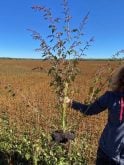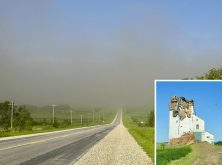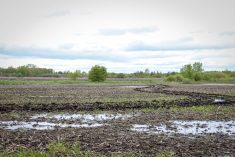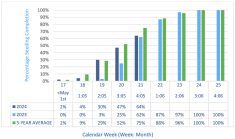The province’s top weed expert is expecting to see lots of sprayers this fall, with many producers hoping to preserve every drop of water left in their soils.
Late-summer rains broke Manitoba’s months-long dry spell for many regions, “but it’s still not nearly enough, so we’re going to have to be really careful,” said Kim Brown-Livingston, Manitoba Agriculture and Resource Development weed specialist.
Why it matters: Producers typically let nature worry about terminating annual weeds, but this year, those weeds might take some much-needed moisture with them before winter closes in.
Read Also

June brings drought relief to western Prairies
Farmers on the Canadian Prairies saw more rain in June than they did earlier in the 2025 growing season
While perennials — such as Canada thistle, quackgrass, dandelion — and winter annuals like cleavers are typically in the crosshairs this time of year, dry conditions have also sparked more control efforts on annuals, typically left to winterkill.
“Normally, we don’t really talk about going after annual weeds and that kind of thing in the fall. We just kind of let Mother Nature take care of it,” Brown-Livingston said. “But this fall, I think that’s going to make a big difference.”
This year, those annuals are competition for precious moisture and nutrients for the crop to come.
- Read more: Palmer amaranth found in Manitoba
The last months have seen Manitoba caught in historic drought. Outside of western Manitoba, most of the province was still in a state of extreme or exceptional drought at the end of August, according to the Canadian Drought Monitor.
At the same time, Brown-Livingston noted, current fertilizer price is incentive for the producer to protect as much nutrient as possible rather than let it drain into weeds, although that loss would be mitigated if weeds were terminated and worked back in soil.
The weed specialist noted that similar issues are being noted in fields that are cover cropped.
Tough year
In general, 2021 was far from the greatest spray year. While producers were able to get on fields early, dry weather left little initially growing. Producers were reluctant to jump into the sprayer cab, hoping to wait for a greater flush, and few burn-offs were completed. Added to that, the province reports, high wind and wildly fluctuating temperatures in spring helped harden off weeds, while dust on the leaves reduced uptake.
Weeds also had much better competition compared to an often struggling crop.
The result, Brown-Livingston said, was a wealth of large, green weeds by the time combines rolled.
Despite an early appearance of clean fields, there were weeds out there, small to spot, but eager to grow once better conditions emerged.

Weird weeds
Some of those weeds might be less familiar to producers this year.
For those watching the weather, as well as those who noted widespread salinity thanks to drought, it may come as no surprise that 2021 was a good year for foxtail barley and kochia. Brown-Livingston noted that kochia was being found in fields where it had previously never been seen.
Lamb’s quarters, likewise, saw a wealth of escapes this year.
Other weeds, however, were less common.
Brown-Livingston noted several unusual pigweed-related problems, such as smooth pigweed, a species that the weed expert has not noted before and that is a Tier 1 noxious weed. Likewise, the weed specialist reported more cases of waterhemp found this year.
“It was just the weather,” she said. “They’re warm-season weeds. They like the hot, dry weather and they do really well. Some of them emerge a little bit later though, so maybe some of these weren’t there first thing in the spring when we were looking to do some spraying, but they sure made up for it later on with a lot of growth.”
The province is also reporting its first possible case of Palmer amaranth, the top weed problem in the U.S., according to North Dakota State University, after the weed was detected in that state several years ago. U.S. research has described significant yield losses (up to 93 per cent in some soybean fields) due to the prolific species infamous for resistance risk.
Since being found in North Dakota, weed experts in Manitoba have been carefully watching and waiting for the species to jump the Canada-U.S. border.
The province has sent samples to confirm or disprove whether the weed in question was Palmer amaranth.

Best practices
The province’s weather has been kind to fall weed control efforts so far. Temperatures largely remained in the late teens, creeping as high as almost 29 C throughout the month of September, while also dodging frost in the overnight lows.
Experts commonly urge producers to only spray while plants are actively growing, to ensure uptake, and to therefore avoid spraying within two to three days of a frost. About 60 per cent of the leaf should be alive at the time of spraying, according to provincial guidelines.
Brown-Livingston suggests spraying only after temperatures have been over 8 C for several hours, targeting the mid-morning or afternoon.
Likewise, she urged, producers should not be in too much of a hurry following harvest. Weeds must have a regrowth period for fall control to be most effective, she said. That post-harvest window should stretch four to six weeks, or when weeds reach a four-leaf stage.
Some spray timing will depend on the type of weeds in the crosshairs, Brown-Livingston added. If the farmer is mostly fighting perennials, for example, they should be ramping up to start control in September or October, while winter annuals can be pushed back to the later stages of fall. That timing ensures as many of those annuals as possible are out of the ground and vulnerable before spray hits.
Because conditions are generally less friendly to vigorous growth in fall, producers should also beware cutting glyphosate treatments short, the provincial weed expert said. Little leaf material means less opportunity for uptake, Brown-Livingston said, and a cut rate, alongside that lack of surface area, threatens to make the product less productive at reduced levels.
In general Brown-Livingston urged producers to be carefully scouting their fields this fall.
“If you’re not sure what it is, find out,” she said. “Either send some pictures around or, if it is a pigweed, then find out which one.”
For more content related to drought management visit The Dry Times, where you can find a collection of stories from our family of publications as well as links to external resources to support your decisions through these difficult times.





















